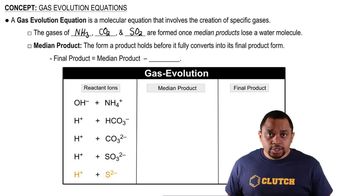(a) How many milliliters of 0.120 M HCl are needed to completely neutralize 50.0 mL of 0.101 M Ba(OH)2 solution?
Some sulfuric acid is spilled on a lab bench. You can neutralize the acid by sprinkling sodium bicarbonate on it and then mopping up the resulting solution. The sodium bicarbonate reacts with sulfuric acid according to: 2 NaHCO3(s) + H2SO4(aq) → Na2SO4(aq) + 2 H2O(l) + 2 CO2(g). Sodium bicarbonate is added until the fizzing due to the formation of CO2(g) stops. If 27 mL of 6.0 M H2SO4 was spilled, what is the minimum mass of NaHCO3 that must be added to the spill to neutralize the acid?
 Verified step by step guidance
Verified step by step guidanceKey Concepts
Stoichiometry

Molarity

Gas Evolution Reaction

(b) How many milliliters of 0.125 M H2SO4 are needed to neutralize 0.200 g of NaOH?
(c) If 55.8 mL of a BaCl2 solution is needed to precipitate all the sulfate ion in a 752-mg sample of Na2SO4, what is the molarity of the BaCl2 solution?
The distinctive odor of vinegar is due to acetic acid, CH3COOH, which reacts with sodium hydroxide according to: CH3COOH1aq2 + NaOH1aq2¡ H2O1l2 + NaCH3COO1aq2 If 3.45 mL of vinegar needs 42.5 mL of 0.115 M NaOH to reach the equivalence point in a titration, how many grams of acetic acid are in a 1.00-qt sample of this vinegar?
A 4.36-g sample of an unknown alkali metal hydroxide is dissolved in 100.0 mL of water. An acid–base indicator is added, and the resulting solution is titrated with 2.50 M HCl(aq) solution. The indicator changes color, signaling that the equivalence point has been reached, after 17.0 mL of the hydrochloric acid solution has been added. (a) What is the molar mass of the metal hydroxide?
A 4.36-g sample of an unknown alkali metal hydroxide is dissolved in 100.0 mL of water. An acid–base indicator is added, and the resulting solution is titrated with 2.50 M HCl(aq) solution. The indicator changes color, signaling that the equivalence point has been reached, after 17.0 mL of the hydrochloric acid solution has been added. (b) What is the identity of the alkali metal cation: Li+, Na+, K+, Rb+, or Cs+?
